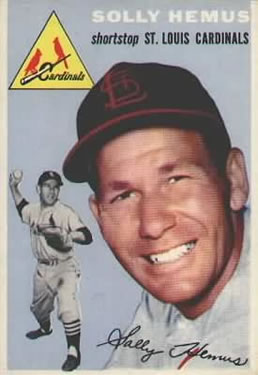On this date in 1959, 36 year old Solly Hemus entered the game in the 8th inning as a pinch-hitter for shortstop Alex Grammas. The St Louis Cardinals, playing at home, entered the 8th down 3-1 to the Cincinnati Reds. With two out, George Crowe doubled home Ken Boyer, reducing the Reds' margin to one, and Solly came to the plate with Crowe on second and a chance to even the score. Instead, he hit a weak grounder to shortstop Eddie Kasko who made the easy throw to first, ending the inning. It was Solly's last appearance as a player in a major league game.

My first memory of collecting baseball cards was of the most frequent cards being those of Phillies shortstop Granny Hamner and Solly Hemus of the Cards, so this must have been 1959, or possibly 1958 (when Hemus was also with the Phillies). It was always a disappointment getting Granny or Solly because I wanted the big sluggers and top pitchers who were rarities in the card sets we purchased, although a stick of gum came with each pack!
Solomon Joseph Hemus was a shortstop, second baseman, and pinch hitter, who came up to the Cards in 1949, after spending four years during WW2 as an ordnance loader on aircraft carriers, playing with the Birds until traded to the Phillies during the 1956 season and returning to St Louis before the 1959 season.
Born in Phoenix in 1923, Solly's SABR biography starts with this description:
Pepper pot. Bulldog. Firebrand. Scrapper. Solly Hemus answered to all those descriptions in 11 years as a major-league player and 2½ as a manager.
It goes on to quote Cards GM Bing Devine, “Solly was a hell-bent-for-leather, fiery ballplayer with limited talent.”
Hemus was considered a weak defensive infielder. That description is consistent across the board from the observers reported in the SABR biography. However, it raises an interesting question about the newer baseball metrics, because from 1951 through 1953, Hemus is rated by Baseball-Reference as the fourth, first, and sixth rated defensive player in the National League according to Wins Above Replacement (WAR). Defensive performance is notoriously difficult to quantify and I think it more likely this is a problem with WAR than with contemporary observers.
Solly is also rated by WAR as a top ten offensive player in 1952 and 1953, even though his conventional stats (HR/RBI/Avg) don't look too impressive (15/52/.268 and 14/61/.279). However, he drew a lot of walks, something no one was paying a lot of attention to at the time, finishing 4th and 5th in the league, making him 6th and 3rd in on-base percentage (another stat no one used at the time). His effectiveness as a hitter also explains his extended career as a pinch hitter after he stopped being a regular after the '53 season.
According to the SABR biography, Solly was also a racist, something that became apparent in his 2 1/2 tenure as Cardinals manager which began with the 1959 season. The Cards were one of the last National League teams to integrate and two young black players, Curt Flood and Bob Gibson, began their careers under Hemus. Both grew to despise their manager for his remarks and treatment; Gibson about to quit baseball because of it until coach Harry Walker persuaded him to stay. Years later Hemus apologized to both players but the damage had been done. The SABR bio concludes with this:
Late in his life he told author David Halberstam that he had grown up and started in baseball in an era when ethnic insults were common, and had failed to keep up with changing times. He always thought of himself as the underdog: “If you can’t hit, you can’t run, and you can’t throw, you’ve got to holler at them.”
Hemus prospered in his post-baseball career and lived until he was 94, passing in 2017.
You’re going to need a new entry for Raffy’s last game. At least in the scarlet Sox.
ReplyDeleteDone!
Delete